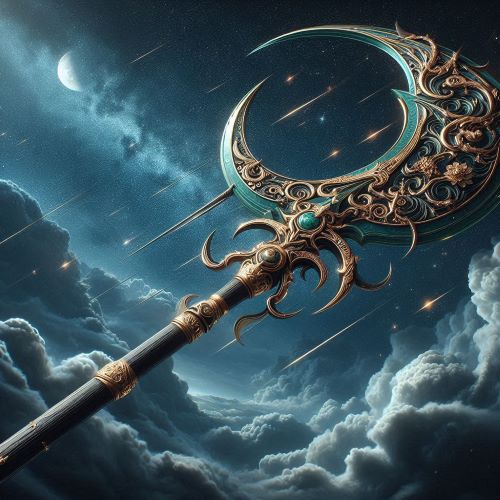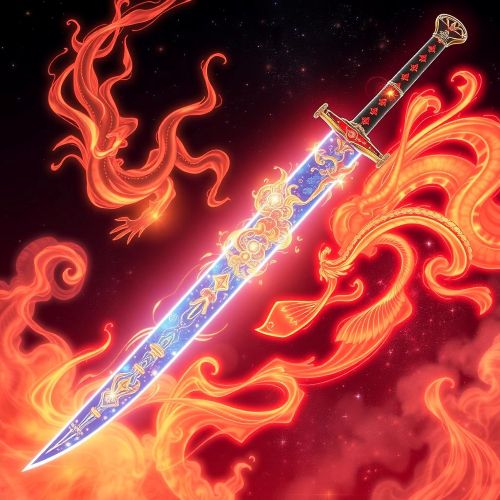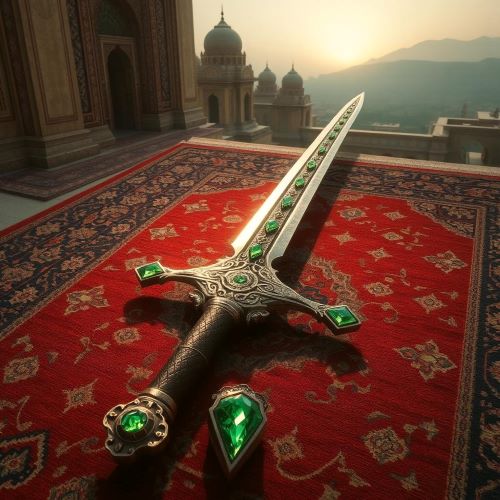Gram : The Dragon Slayer
Gram
Introduction
In the rich world of Norse mythology, few weapons command as much reverence as Gram, the fabled sword of the dragon-slayer Sigurd. Known in Old Norse as meaning “Wrath,” Gram stands alongside legendary blades such as Excalibur and Kusanagi as a symbol of power, destiny, and divine craftsmanship. It is not merely a tool of war, but a narrative force that shapes the fate of kings, heroes, and entire bloodlines. From its divine origins to its decisive role in slaying the fearsome dragon Fafnir, Gram remains an enduring emblem of courage, vengeance, and the inescapable pull of fate.
Origins
The earliest mention of Gram comes from the Völsunga Saga, where its creation is steeped in divine intervention and masterful craftsmanship. In one version, the legendary smith Weyland the Smith forged the blade, while another tradition credits the dwarven brothers Eitri and Brokkr, famed for creating weapons of unmatched quality. However, its story truly begins in the great hall of King Völsung.
During a grand feast, a mysterious one-eyed traveler—none other than Odin in disguise—plunged a sword deep into the trunk of the sacred Barnstokkr tree. The Allfather declared that the man who could draw the weapon from the wood would claim it as his own. Many tried and failed, but Sigmund, the king’s son, succeeded effortlessly. This act bound Gram to the Völsung family and set in motion a chain of events that would ripple through generations. Sigmund named the sword Gram, marking it as a weapon of wrath and divine choice, destined to bring both glory and tragedy.
Think you know your myths and legends? Dive into the world of ancient stories and test your knowledge with our engaging quizzes on Mythlok!
Powers
Gram’s abilities elevated it far above ordinary weapons. It was renowned for being unbreakable, able to withstand the fiercest blows and, when shattered, capable of being reforged without losing its potency. More than a simple weapon, Gram was an instrument of fate—appearing in the hands of those marked for greatness and doom alike.
Its most famous attribute was its unparalleled effectiveness against dragons. In myth, it was the only blade capable of piercing the armored hide of Fafnir, a serpent so fearsome that no other weapon could wound him. Gram was also described as possessing a supernatural brilliance: in some tellings, its golden hilt shone with an otherworldly glow, reflecting its divine origin. Beyond battle, Gram symbolized the burden of kingship and heroism, bringing its wielder honor while also drawing envy, betrayal, and ruin.
Owners/Users
Gram’s legacy is inseparable from the tragic and heroic figures who wielded it. Sigmund, its first owner, carried it into battle against formidable foes, only to have it shattered when Odin intervened in disguise during a duel. This act signaled that Sigmund’s time with the sword—and indeed his life—was ending, but that Gram’s destiny was far from over.
The broken pieces eventually came into the hands of Sigurd, Sigmund’s son, raised by the master smith Regin. Regin reforged Gram for the young hero, creating a blade so sharp that it could split an anvil in two during testing. With this reforged sword, Sigurd became the most famous wielder of Gram, using it to achieve one of Norse mythology’s most celebrated feats—the slaying of Fafnir.
In later traditions, Gram passed through other hands as the sagas evolved. The Thiðrek Saga recounts that Roðingeir gave the sword to Gislher, while certain legends tell of the goddess Freyja’s essence merging with the sword after a battle. Yet in every telling, Gram retains its role as a weapon of destiny, never lingering long with any one owner before fate calls it elsewhere.
Instances used
Gram’s appearances in Norse literature are tied to defining moments in myth. Its first great test came during Sigmund’s battles, where it proved unmatched in combat until Odin’s intervention caused it to shatter. This breaking was not the end, but a pause—a sign that its true purpose lay with Sigurd.
The reforging of Gram by Regin was itself a moment of legend. Once the sword was remade, its sharpness was beyond question: it could cleave through solid iron and part objects with a single stroke. This restoration symbolized not only the renewal of the weapon but also the continuation of the Völsung destiny.
The most famous episode involving Gram is Sigurd’s confrontation with Fafnir. Guided by Regin’s counsel, Sigurd dug a pit along the dragon’s path, lying in wait until Fafnir crossed over. With a single, decisive thrust, Sigurd drove Gram into the dragon’s heart, fulfilling a prophecy and cementing his place as a hero of Norse legend. The slaying of Fafnir not only brought Sigurd immense wealth but also set the stage for his tragic end, proving that even the mightiest weapons cannot shield their bearers from fate.
In some accounts, Gram plays a role in Sigurd’s own downfall, wielded in acts of betrayal that echo the cyclical nature of vengeance in Norse myth. This reinforces the idea that in the sagas, a weapon like Gram is as much a character as the heroes who hold it—shaping destinies, exacting justice, and sealing tragic ends.
Frequently Asked Questions
Lorem ipsum dolor sit amet, consectetur adipiscing?
Lorem ipsum dolor sit amet, consectetur adipiscing elit. Praesent convallis vestibulum justo, ac tincidunt nunc vehicula quis. Nullam id dolor quis orci malesuada feugiat. Curabitur aliquet libero at urna ullamcorper, ac ultricies nulla dapibus.
Lorem ipsum dolor sit amet, consectetur adipiscing?
Lorem ipsum dolor sit amet, consectetur adipiscing elit. Praesent convallis vestibulum justo, ac tincidunt nunc vehicula quis. Nullam id dolor quis orci malesuada feugiat. Curabitur aliquet libero at urna ullamcorper, ac ultricies nulla dapibus.
Lorem ipsum dolor sit amet, consectetur adipiscing?
Lorem ipsum dolor sit amet, consectetur adipiscing elit. Praesent convallis vestibulum justo, ac tincidunt nunc vehicula quis. Nullam id dolor quis orci malesuada feugiat. Curabitur aliquet libero at urna ullamcorper, ac ultricies nulla dapibus.
Lorem ipsum dolor sit amet, consectetur adipiscing?
Lorem ipsum dolor sit amet, consectetur adipiscing elit. Praesent convallis vestibulum justo, ac tincidunt nunc vehicula quis. Nullam id dolor quis orci malesuada feugiat. Curabitur aliquet libero at urna ullamcorper, ac ultricies nulla dapibus.
Lorem ipsum dolor sit amet, consectetur adipiscing?
Lorem ipsum dolor sit amet, consectetur adipiscing elit. Praesent convallis vestibulum justo, ac tincidunt nunc vehicula quis. Nullam id dolor quis orci malesuada feugiat. Curabitur aliquet libero at urna ullamcorper, ac ultricies nulla dapibus.
Watch
Source
Gaiman, N. (2017). Norse mythology. Bloomsbury.
Lindow, J. (2002). Norse mythology: a guide to the Gods, heroes, rituals, and beliefs. Oxford University Press.
Sturluson, S. (2005). The prose Edda : Norse mythology..
Berloga-Workshop. (2019, December 6). Gram – Berloga Workshop. https://berloga-workshop.com/blog/256-gram.html.
Dungeons & Dragons Lore Wiki. (n.d.). Gram. Retrieved from https://dungeonsdragons.fandom.com/wiki/Gram.
Justapedia. (2022, September 24). Gram (mythology). https://justapedia.org/wiki/Gram_(mythology).
Kiddle. (2025, June 10). Gram (mythology) Facts for Kids. https://kids.kiddle.co/Gram_(mythology).
Medieval-Shop. (n.d.). Viking Sword Gram: Myth and Legend ⚔ Medieval-Shop. Retrieved from https://www.medieval-shop.co.uk/faq/faqs/what-is-the-viking-sword-gram.
Mythus Wiki. (n.d.). Gramr. Retrieved from https://mythus.fandom.com/wiki/Gramr.
Reliks. (n.d.). Gram The Sword of Sigurd – Viking Swords at Reliks.com. Retrieved from https://www.reliks.com/viking-swords/gram-the-sword-of-sigurd/.
Seven Swords. (n.d.). Swords from Norse myth. Retrieved from https://sevenswords.uk/swords-from-norse-myth/.









